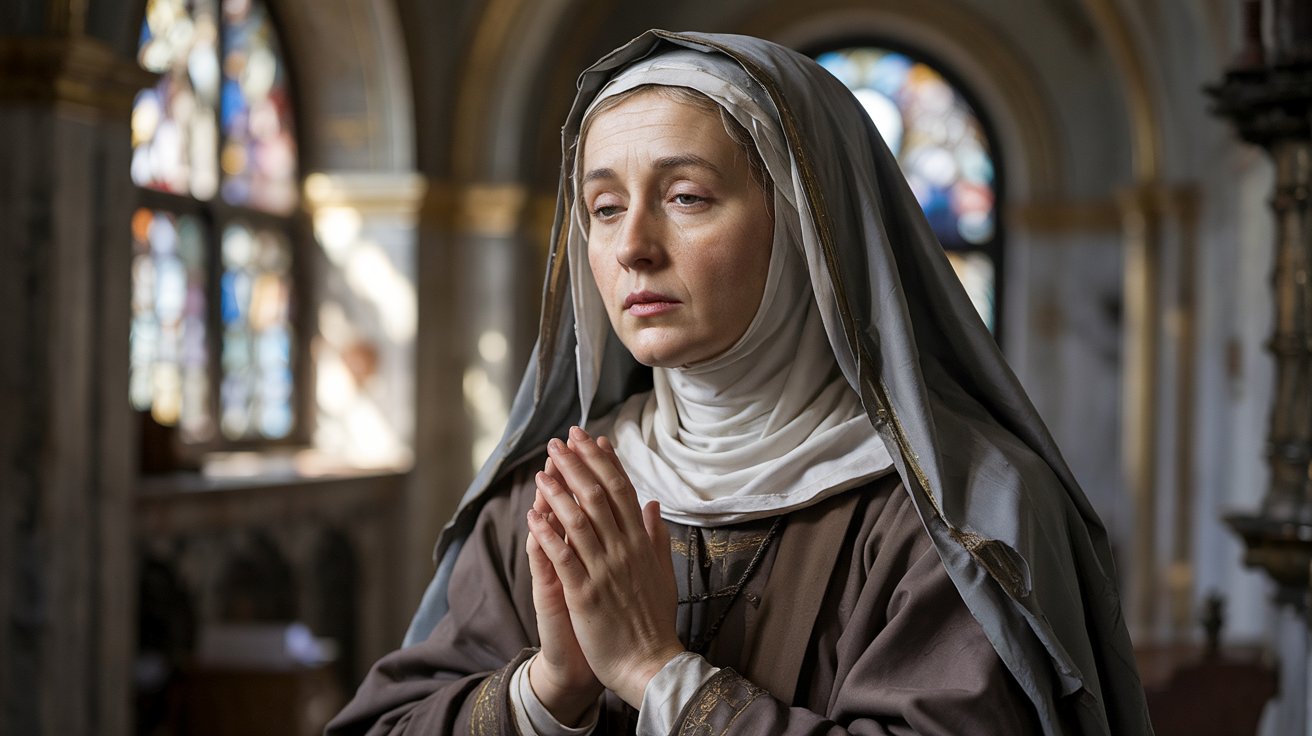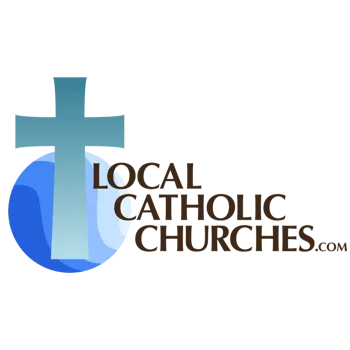Quick Reference Table
| Aspect | Details |
|---|---|
| Full Name | Caterina di Jacopo di Benincasa (known in English as Catherine of Siena) |
| Dates | Born: March 25, 1347 (Siena, Italy) Died: April 29, 1380 (Rome, Italy) |
| Feast Day | April 29 |
| Religious Order | Dominican Tertiary (the Mantellate of the Third Order of Saint Dominic) |
| Major Works | The Dialogue of Divine Providence, over 300 letters, various prayers |
| Titles | Mystic, Doctor of the Church (declared 1970), Co-Patroness of Italy, Co-Patroness of Europe |
| Patronages | Italy, Europe, fire prevention, nurses, those ridiculed for their faith |
| Key Devotions | Devotion to the Passion of Christ, the Precious Blood, and Christ’s mystical body (the Church) |
| Symbols | Lily (chastity and purity), stigmata, a crown of thorns (referring to her mystical unity with Christ’s suffering) |
| Major Shrine | Basilica of San Domenico (Siena), containing her head; her body is interred in Santa Maria sopra Minerva (Rome) |
| Canonization | 1461 by Pope Pius II |
| Notable Attributes | Counselor of Popes, mediator, mystic, peacemaker, tireless advocate for Church reform |
Introduction
Saint Catherine of Siena (1347–1380) was a Dominican mystic, theologian, and influential spiritual advisor during a turbulent period of Church history. Born into a large family in medieval Siena, she dedicated herself to Christ from an early age and joined the Third Order of Saint Dominic, embracing a life of rigorous prayer, asceticism, and service. Despite her lack of formal education, her letters and spiritual treatises—especially her most famous work, The Dialogue of Divine Providence—would shape Western spirituality and theology for centuries. Renowned for her role in urging the papacy’s return from Avignon to Rome, she was canonized in 1461 and proclaimed a Doctor of the Church in 1970. Her feast day is celebrated on April 29.
Early Life and Spiritual Growth
- Birth and Family Background
- Catherine was born on March 25, 1347, the 23rd child of Jacopo di Benincasa (a wool dyer) and Lapa Piagenti. Many of her siblings did not survive infancy, but Catherine’s robust health allowed her to flourish.
- From an early age, she exhibited deep piety. By the time she was six, she is said to have experienced her first vision—beholding Christ seated in glory.
- Consecration to Christ
- At age seven, Catherine privately vowed her virginity to Christ. She resisted family pressures to marry and dedicated herself increasingly to prayer and acts of charity.
- She joined the Mantellate, the Third Order of the Dominicans, around age sixteen or seventeen, wearing the simple habit and living partly as a recluse in her family home.
- Intense Prayer and Ascetic Practices
- Catherine developed a profound prayer life marked by mystical experiences, fasting, and severe penances.
- Through these ascetic disciplines, she cultivated a deep spiritual connection with Christ, often referring to him as her “Divine Spouse.”
Public Ministry and Influence
- Outreach and Service
- Despite periods of seclusion, Catherine felt called by God to serve the poor and the sick. She nursed plague victims, visited hospitals, and gave spiritual counsel.
- A charismatic figure, she attracted a group of followers, known as her “caterinati,” who witnessed her remarkable devotion and sought her guidance.
- Political Mediation and Papal Affairs
- Catherine lived in an era of Church turmoil, including the Avignon Papacy (1309–1377), when popes resided in Avignon, France, rather than Rome.
- She corresponded with and personally advised Pope Gregory XI, urging him to leave Avignon and re-establish the papal seat in Rome to restore Church unity.
- Catherine’s passionate appeals contributed to Gregory XI’s eventual return to Rome in 1377, a significant event in Church history.
- Active Role in Church Reform
- Although a laywoman without formal theological training, Catherine was fearless in admonishing both secular and ecclesiastical leaders. She wrote letters to princes, cardinals, and the pope himself, advocating reform, peace, and fidelity to Christ.
- During the Western Schism (which began in 1378), when rival popes claimed legitimacy, Catherine staunchly supported Pope Urban VI. Her efforts helped clarify the Church’s position for many.
Mystical Experiences and Writings
- The Dialogue of Divine Providence
- Composed between 1377 and 1378, The Dialogue is the record of her mystical conversations with God. In it, the Eternal Father speaks to Catherine about love, providence, prayer, virtue, and the path to holiness.
- The text stands as a masterpiece of late medieval spirituality, blending theology, allegory, and moral instruction.
- Letters
- Over 300 letters from Catherine survive, addressed to a wide range of recipients—popes, royalty, religious figures, and ordinary laypeople.
- They reveal her direct, often urgent tone, emphasizing repentance, devotion to Christ, and obedience to legitimate Church authority.
- Prayers
- Catherine also composed a number of shorter prayers, reflecting her passionate devotion to Christ’s Passion, the Eucharist, and the unity of the Church.
- Mystical Union and the Stigmata
- Catherine is said to have received the invisible stigmata in 1375, the wounds of Christ that did not manifest outwardly until her death.
- She frequently spoke of a “mystical marriage” with Christ, describing an exchange of hearts: “I have taken away your heart…and now I give you mine.”
Final Years and Death
- Sacrificial Living
- Catherine’s rigorous asceticism took a physical toll. Many accounts detail her severe fasting and self-mortification, eventually weakening her health.
- She continued her mission, writing letters and advocating Church unity amid the Great Western Schism (1378–1417).
- Death
- She died on April 29, 1380, at approximately 33 years of age, in Rome. Her last years were devoted to fervent prayer for the Church’s fidelity.
- Relics and Veneration
- Catherine’s body was interred at the Dominican church of Santa Maria sopra Minerva in Rome. Her head and thumb were later enshrined in Siena at the Basilica of San Domenico.
- Devotion to Catherine spread rapidly; many recognized her sanctity and impact on both Church and civic affairs.
Canonization, Doctorate, and Legacy
- Canonization
- Pope Pius II (a Sienese himself) canonized Catherine on June 29, 1461.
- Her feast day is celebrated on April 29 in the Roman Catholic Church.
- Doctor of the Church
- Along with Teresa of Ávila, Catherine was among the first women to be declared a Doctor of the Church in 1970 by Pope Paul VI, recognizing the theological depth and enduring significance of her writings.
- Co-Patroness of Italy and Europe
- By decree of Pope Pius XII (1939), she became a Co-Patroness of Italy with Francis of Assisi.
- In 1999, Pope John Paul II named her a Co-Patroness of Europe alongside Saints Bridget of Sweden and Teresa Benedicta of the Cross (Edith Stein).
- Spiritual Influence
- Catherine’s focus on Christ’s Passion, her unwavering loyalty to the pope, and her call for personal holiness and church renewal remain powerful themes in Catholic devotion.
- Her direct, uncompromising style in addressing both church and secular leaders demonstrates her courage and zeal, reflecting the divine authority she believed was entrusted to her.
Timeline of Key Events
| Date/Period | Event | Significance |
|---|---|---|
| March 25, 1347 | Birth in Siena, Italy | Emergence of a future mystic and influential figure in the Church |
| Early 1360s | Joins the Dominican Third Order (Mantellate) | Commits to a life of prayer, penance, and service |
| 1366 (approx.) | Mystical “Spiritual Espousal” to Christ | Profound experience confirming her vocation to serve Church and society |
| 1374–1378 | Begins dictating The Dialogue of Divine Providence | Produces her greatest theological work |
| 1375 | Receives the invisible stigmata | Symbol of her unity with Christ’s suffering |
| 1376–1377 | Journeys to Avignon to advocate for Pope Gregory XI’s return to Rome | Assists in ending the Avignon Papacy, a pivotal moment in Church history |
| April 29, 1380 | Dies in Rome at about 33 years old | Culmination of her short life marked by intense devotion and service |
| 1461 | Canonized by Pope Pius II | Formal recognition of her sanctity and contributions |
| 1970 | Declared Doctor of the Church by Pope Paul VI | Acknowledgment of her extraordinary theological insights |
| 1999 | Named Co-Patroness of Europe by Pope John Paul II | Signifies her enduring relevance to European Catholic identity and unity |
Conclusion
Saint Catherine of Siena remains one of the most compelling figures of the late medieval Church—a laywoman, mystic, political mediator, and spiritual teacher who left an indelible mark on Christian history. Her bold appeals for ecclesial reform, her unwavering loyalty to the papacy during times of crisis, and her uncompromising pursuit of holiness have inspired generations. Despite her lack of formal education, her writings reveal a theological depth and fervor that ultimately led to her recognition as a Doctor of the Church.
Her message of love for God, concern for souls, and unity within the Church resonates today, as does her example of bridging contemplation and action. Catherine’s life testifies that, even in an era of great turmoil, a soul entirely devoted to Christ can play a transformative role in both the spiritual and public spheres.






